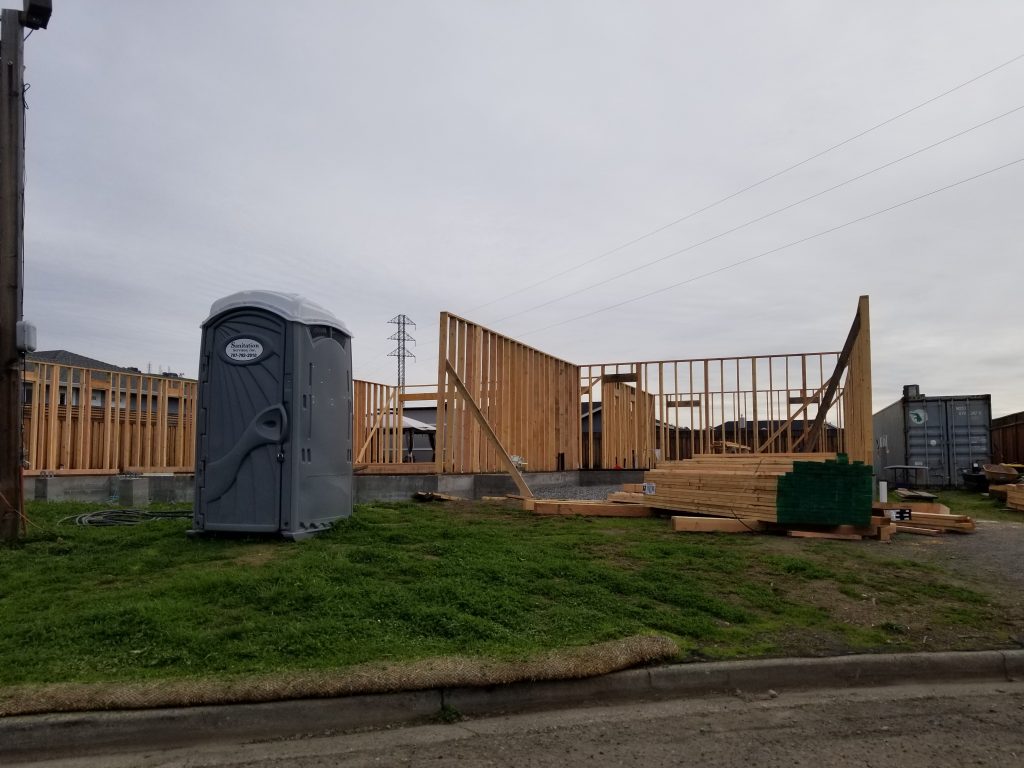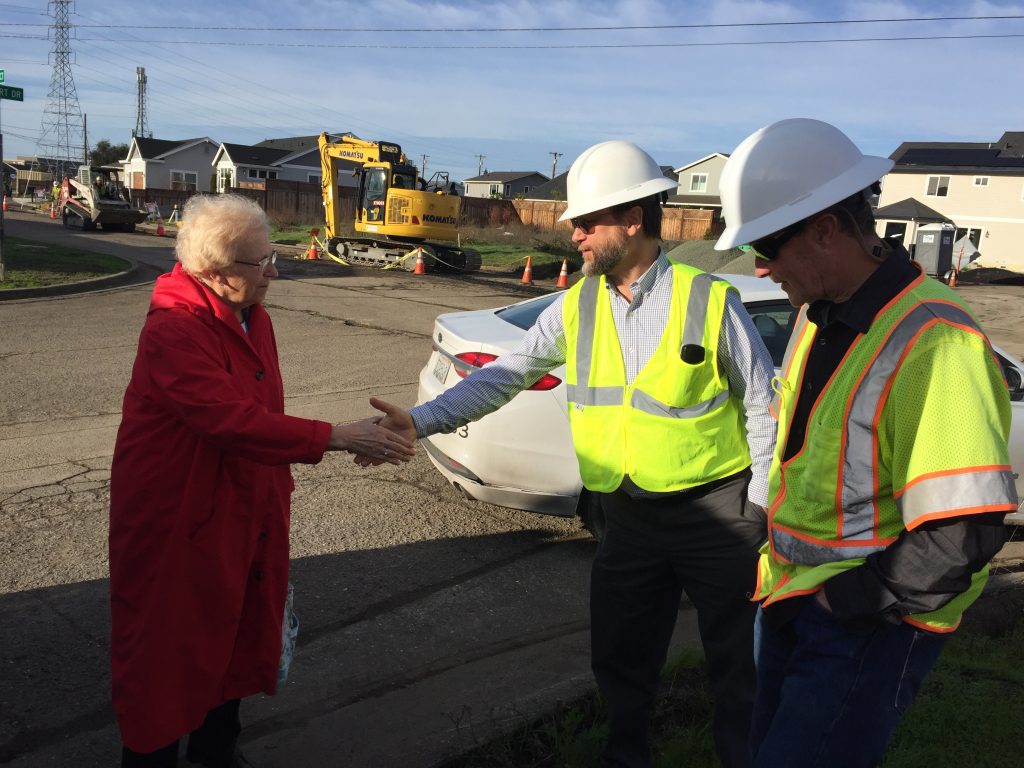
Early on the morning of October 9, 2017, a firestorm roared with unforgiving speed across a swath of northeastern Santa Rosa. The unincorporated community of Larkfield lay directly in its path. One-hundred and sixty homes there burned to the ground.
Three and a half years later, Larkfield is still being rebuilt—in some ways better than ever, thanks in part to an ambitious and innovative program by the Sonoma County Water Agency to bring sewer service to the modest, tight-knit community at the foot of the Mayacamas Mountains.
New homes of all shapes, sizes, styles, and colors, each designed to suit the owner’s preference, are interspersed with dozens more in varying stages of construction. On a recent weekday afternoon, building and landscaping crews labored around Larkfield’s every bend: installing framing, siding, hardscaping, interiors. Another 25 lots remained bare except for a blanket of bright-green spring grass.

Though they appear heterogeneous from street level, below the surface roughly half of Larkfield’s homes are connected for the first time via a hidden network of pipes. Before the fire, the neighborhood largely lacked sewer access, with all but a handful of homes on the perimeter relying instead on septic systems—where household wastewater is passed through small settling tanks before being dispersed in a backyard “leach field.”
Lots are relatively small in Larkfield, ranging in size from 1/4 to 1/3 of an acre. In the 1950s and ‘60s, when most of the original homes were built, that was considered big enough for a septic system—but didn’t leave room for much else. Nowadays, regulations call for at least half an acre in order to protect both human health and the environment, says Mike Thompson, an assistant general manager with Sonoma County Water Agency, also known as Sonoma Water.
“You have the potential with a relatively tight cluster of septic systems to have an issue with groundwater contamination in this area,” Thompson says. “There hadn’t been monitoring done, but definitely a strong potential existed there.”
If excess nutrients or harmful chemicals from wastewater were to infiltrate nearby Mark West Creek, which runs to the north of the neighborhood, they could flow from there to the Russian River, which provides drinking water to more than 600,000 North Bay residents.
“The other issue is if the system fails, it becomes a public health and very direct environmental impact” through more localized, surface-level contamination, Thompson says.
By 2017, many of the neighborhood’s septic systems were approaching the end of their expected lifespan. A few had already failed. If residents rebuilt with their old septic systems still in place and then they failed, Thompson worried they’d be unable to replace them due to current space requirements.
Better for everyone, he figured, would be to finally connect the neighborhood to the sewer system. Residents would gain an alternative to septic, a likely boost in property value, and greater use of their land, while Sonoma Water would acquire another source of recycled water.
“We saw this as a once-in-a-century opportunity to make a community better than it was before this horrible event,” says Thompson, who helped launch and lead the project. “By being able to bring sewer into this area, and do it while everything else was dug up, there were so many advantages.”
Back when the idea first arose in the weeks after the fire, one of Sonoma Water’s main concerns was whether enough property owners would be willing and able to pay the cost, estimated at about $50,000 per parcel, of creating a new sewer collection system in the community. Sure enough, during their first community survey, staff learned that only a quarter of residents were interested.

“It didn’t go very well at first,” says Larkfield resident Chris Mocny, a retired engineering technician with Sonoma County who was already familiar with the local sewer system and liked the idea of extending it to Larkfield. But he was also among those initially discouraged by the expense. “We’re looking at huge costs of rebuilding our homes, and then on top of it you want us to pay for the sewer? So we were very skeptical.”
Then Thompson and his colleagues had an idea: what if the agency offered a deferred loan program to cover the cost, with no payments for ten years? Soon nearly half the residents needing new homes were able to commit. By late 2019, two years after the fire, Sonoma Water was ready to build.
Between January and September 2020, Sonoma Water installed more than a mile and a half of eight- and six-inch PVC sewer main at depths ranging from three to 14 feet, along with 900 feet of narrower-gauge, low-pressure sewer—and 57 manholes. The project’s “extremely fast” timeline was aided by lighter-than-average traffic due to the pandemic along Mark West Springs Road, which bisects the neighborhood.
Looking forward, as more of Larkfield’s existing septic systems fail but cannot be easily replaced, Sonoma Water expects that more property owners will choose to pay to access the sewer system. And decades after the last home connects, the agency will finally recoup all its expenses—with interest. It will also have gained access to tens of thousands of gallons of additional household wastewater per day to treat and reuse for irrigation, industry, environmental restoration, and more.
Along with augmenting recycled water use, the project supports climate resilience in a county that has been hammered by drought, flood, and fire in recent years by freeing up yard space in sewer-connected homes for accessory dwelling units, maximizing housing availability and density in the conveniently located neighborhood. In addition, public sewer systems are generally more resistant to damage from fires and other natural disasters than private septic systems.
“Resilience is more than just building a sewer project,” says Brad Sherwood, Sonoma Water community and goverment affairs manager. “For Sonoma Water, resilience means investing in infrastructure that will help future generations of Sonoma County residents battle climate change.”
On a recent afternoon, one elderly resident who asked that her name not be used said she has lived in Larkfield for 20 years, and was happy to trade in her old septic system for a sewer connection. The deferred loan made it possible for her, she said.
Standing outside her newly rebuilt home, watering her freshly planted landscaping with a garden hose, she looked across the street. Where her former neighbors once lived, an empty lot sat quiet: a reminder that while Larkfield has come a long way since the fire, recovery continues.
Larkfield Project, Sonoma Water
Prior Estuary News Stories
EBMUD Experiments with Pipe Replacement, June 2016
Top Photo: Digging a sewer lateral in Larkfield: Photo courtesy: Sonoma Water